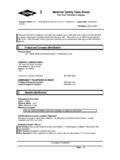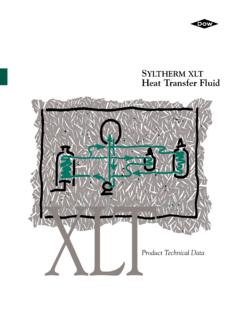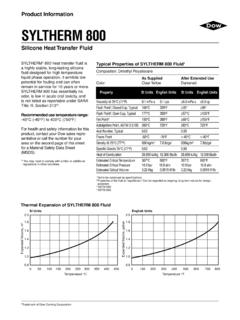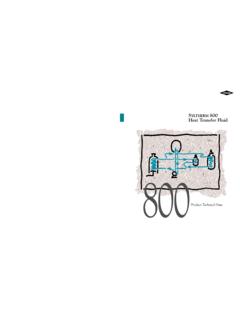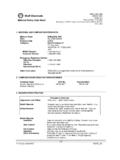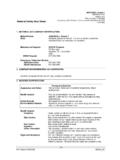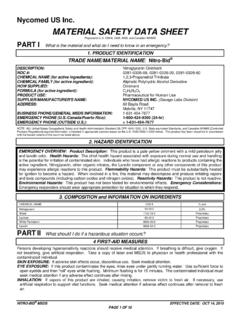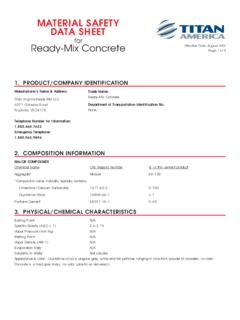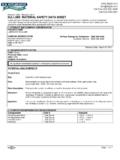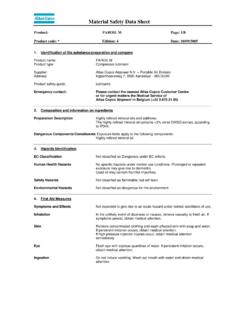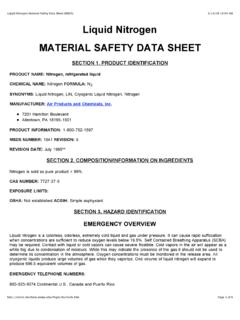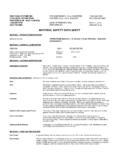Transcription of Material Safety Data Sheet - Loikits Distribution
1 Product Name: SYLTHERM XLT# Heat Transfer Fluid Issue date : 11/01/2011 Print date : 28 Dec 2011 (TM)*Trademark Page 1 of 8 The Dow Chemical Company encourages and expects you to read and understand the entire (M)SDS, as there is important information throughout the document. We expect you to follow the precautions identified in this document unless your use conditions would necessitate other appropriate methods or actions. 1. Product and Company Identification Product Name SYLTHERM XLT# Heat Transfer Fluid COMPANY IDENTIFICATION The Dow Chemical Company 2030 Willard H. Dow Center Midland, MI 48674 USA Customer Information Number: 800-258-2436 EMERGENCY TELEPHONE NUMBER 24-Hour Emergency Contact: 989-636-4400 Local Emergency Contact: 989-636-4400 2.
2 Hazards Identification Emergency Overview Color: Clear Physical State: Liquid. Odor: Odorless to mild Hazards of product:CAUTION! Combustible liquid and vapor. May be harmful if inhaled. Aspiration hazard. Can enter lungs and cause damage. Isolate area. Keep upwind of spill. OSHA Hazard Communication Standard This product is a Hazardous Chemical as defined by the OSHA Hazard Communication Standard, 29 CFR Potential Health Effects Eye Contact: May cause slight temporary eye irritation. Corneal injury is unlikely. May cause mild eye discomfort. Skin Contact: Prolonged contact is essentially nonirritating to skin. Prolonged or repeated exposure may cause defatting of the skin leading to drying or flaking of skin.
3 Skin Absorption: Prolonged skin contact is unlikely to result in absorption of harmful amounts. Material Safety data Sheet The Dow Chemical Company Product Name: SYLTHERM XLT# Heat Transfer Fluid Issue date : 11/01/2011 Page 2 of 8 Inhalation: Prolonged excessive exposure may cause adverse effects. Signs and symptoms of excessive exposure may include: May cause dizziness and drowsiness. Ingestion: Very low toxicity if swallowed. Harmful effects not anticipated from swallowing small amounts. Aspiration hazard: Aspiration into the lungs may occur during ingestion or vomiting, causing lung damage or even death due to chemical pneumonia.
4 Component CAS # Amount Dimethylpolysiloxane 63148-62-9 % 4. First-aid measures Description of first aid measures General advice: First Aid responders should pay attention to self-protection and use the recommended protective clothing (chemical resistant gloves, splash protection). If potential for exposure exists refer to Section 8 for specific personal protective equipment. Inhalation: Move person to fresh air; if effects occur, consult a physician. Skin Contact: Wash skin with plenty of water. Eye Contact: Flush eyes thoroughly with water for several minutes. Remove contact lenses after the initial 1-2 minutes and continue flushing for several additional minutes.
5 If effects occur, consult a physician, preferably an ophthalmologist. Ingestion: Do not induce vomiting. Call a physician and/or transport to emergency facility immediately. Most important symptoms and effects, both acute and delayed Aside from the information found under Description of first aid measures (above) and Indication of immediate medical attention and special treatment needed (below), no additional symptoms and effects are anticipated. Indication of immediate medical attention and special treatment needed The decision of whether to induce vomiting or not should be made by a physician. If lavage is performed, suggest endotracheal and/or esophageal control.
6 Danger from lung aspiration must be weighed against toxicity when considering emptying the stomach. No specific antidote. Treatment of exposure should be directed at the control of symptoms and the clinical condition of the patient. Skin contact may aggravate preexisting dermatitis. 5. Fire Fighting Measures Suitable extinguishing media Water fog or fine spray. Dry chemical fire extinguishers. Carbon dioxide fire extinguishers. Foam. General purpose synthetic foams (including AFFF type) or protein foams are preferred if available. Alcohol resistant foams (ATC type) may function. Special hazards arising from the substance or mixture Hazardous Combustion Products: During a fire, smoke may contain the original Material in addition to combustion products of varying composition which may be toxic and/or irritating.
7 Combustion products may include and are not limited to: Carbon monoxide. Carbon dioxide. Unusual Fire and Explosion Hazards: Violent steam generation or eruption may occur upon application of direct water stream to hot liquids. Liquid mist of this product can burn. Flammable concentrations of vapor can accumulate at temperatures above flash point; see Section 9. Advice for firefighters Fire Fighting Procedures: Keep people away. Isolate fire and deny unnecessary entry. Do not use direct water stream. May spread fire. Burning liquids may be moved by flushing with water to protect personnel and minimize property damage. Avoid accumulation of water.
8 Product may be carried across water surface spreading fire or contacting an ignition source. 3. Composition Information Product Name: SYLTHERM XLT# Heat Transfer Fluid Issue date : 11/01/2011 Page 3 of 8 Special Protective Equipment for Firefighters: Wear positive-pressure self-contained breathing apparatus (SCBA) and protective fire fighting clothing (includes fire fighting helmet, coat, trousers, boots, and gloves). If protective equipment is not available or not used, fight fire from a protected location or safe distance. 6. Accidental Release Measures Personal precautions, protective equipment and emergency procedures: Vapor explosion hazard.
9 Keep out of sewers. Isolate area. Keep unnecessary and unprotected personnel from entering the area. Keep upwind of spill. Ventilate area of leak or spill. No smoking in area. Eliminate all sources of ignition in vicinity of spill or released vapor to avoid fire or explosion. Ground and bond all containers and handling equipment. Refer to Section 7, Handling, for additional precautionary measures. Use appropriate Safety equipment. For additional information, refer to Section 8, Exposure Controls and Personal Protection. Environmental precautions: Prevent from entering into soil, ditches, sewers, waterways and/or groundwater. See Section 12, Ecological Information.
10 Methods and materials for containment and cleaning up: Vapor explosion hazard. Keep out of sewers. Eliminate all sources of ignition in vicinity of spill or released vapor to avoid fire or explosion. Material will float on water. Pump with explosion-proof equipment. If available, use foam to smother or suppress. Small spills: Contain spilled Material if possible. Absorb with materials such as: Cat litter. Sawdust. Vermiculite. Zorb-all . Collect in suitable and properly labeled containers. Large spills: Dike area to contain spill. See Section 13, Disposal Considerations, for additional information. 7. Handling and Storage Handling General Handling: Keep away from heat, sparks and flame.
